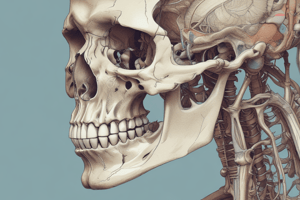Podcast
Questions and Answers
Why are bones considered an organ?
Why are bones considered an organ?
Bones are considered organs because they contain several different types of tissues such as nerves, blood tissue, cartilage, and others besides bone.
Name 6 functions of bones.
Name 6 functions of bones.
Support, movement, protection, mineral storage, blood cell formation, and energy metabolism.
Describe in detail the gross anatomy of a long bone.
Describe in detail the gross anatomy of a long bone.
Long bones are long and wide with two distinct ends.
Describe the gross anatomy of flat, short, and irregular bones.
Describe the gross anatomy of flat, short, and irregular bones.
Describe differences between compact bone tissue and spongy bone tissue.
Describe differences between compact bone tissue and spongy bone tissue.
Describe the chemical composition of bone and distinguish between its organic and inorganic components.
Describe the chemical composition of bone and distinguish between its organic and inorganic components.
What is intramembranous ossification? List and describe the 4 phases of this process.
What is intramembranous ossification? List and describe the 4 phases of this process.
What is endochondral ossification? List and describe the 5 phases of this process.
What is endochondral ossification? List and describe the 5 phases of this process.
Describe the postnatal growth of long bones. How do bones lengthen and widen? Describe the microscopic anatomy of the epiphyseal plate.
Describe the postnatal growth of long bones. How do bones lengthen and widen? Describe the microscopic anatomy of the epiphyseal plate.
Flashcards are hidden until you start studying
Study Notes
Bones as Organs
- Bones comprise various tissues: nerves, blood, cartilage, and bone, classifying them as organs.
Functions of Bones
- Provide support by forming a hard framework for the body.
- Enable movement as skeletal muscles attach to bones via tendons.
- Protect vital organs, such as the brain and heart, enclosed within structures like the skull and rib cage.
- Act as a mineral reservoir, particularly for calcium and phosphorus.
- Involved in blood cell formation and store fat through red and yellow bone marrow.
- Influence energy metabolism and blood sugar regulation by secreting specific hormones.
Gross Anatomy of Bones
- Long Bones: Characterized by a length greater than width, featuring two distinct ends.
- Flat Bones: Thin, flattened, and sometimes curved, such as the skull.
- Short Bones: Cube-like in shape, facilitating stability and support (e.g., wrist bones).
- Irregular Bones: Varied shapes, not fitting other categories, potentially with holes.
Bone Tissue Types
- Compact Bone: Dense outer layer, structured into functional units known as osteons.
- Spongy Bone: Located beneath compact bone, composed of trabecular meshwork housing red marrow.
Chemical Composition of Bone
- Organic Components: Consist of cells and osteoids, contributing to flexibility (approx. one-third of the matrix).
- Inorganic Components: Primarily calcium phosphate, providing structural strength.
Intramembranous Ossification
- Involves bone formation in the skull and clavicles, bypassing cartilage.
- Phases:
- Mesenchymal cells cluster in connective tissue and transform into osteoblasts.
- Osteoblasts secrete osteoid, which mineralizes to form bone matrix.
- Once encased in the matrix, osteoblasts become osteocytes; woven bone develops without lamellae.
- Trabecular bone thickens at the periphery, transitioning to compact bone while spongy bone remains distinct.
Endochondral Ossification
- Formation of bone replacing hyaline cartilage; growth continues into early adulthood.
- Phases:
- Blood vessels invade perichondrium, creating a bone-forming periosteum and initiating collar bone deposition.
- Cartilage center calcifies and deteriorates, forming cavities while peripheral cartilage continues to grow.
- Periosteal bud infiltrates the diaphysis, forming the primary ossification center and spongy bone.
- Continued lengthening through calcification; formation of secondary ossification centers as epiphyses ossify.
Postnatal Growth of Long Bones
- Growth stimulated by the pituitary gland at epiphyseal plates, regulated by the thyroid.
- Lengthening occurs as cartilage cells in the epiphyseal plate proliferate and mature.
- Widening occurs via osteoblast activity in the periosteum and osteoclast activity on the diaphysis.
- Microscopic anatomy of the epiphyseal plate:
- Resting Zone: Quiescent cartilage cells.
- Proliferation Zone: Actively mitotic cartilage cells.
- Hypertrophic Zone: Enlarged older cartilage cells, contributing to overall bone growth.
Studying That Suits You
Use AI to generate personalized quizzes and flashcards to suit your learning preferences.




